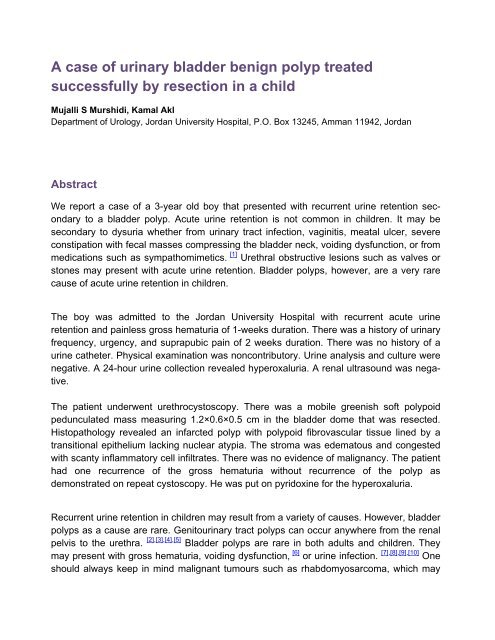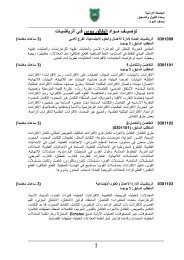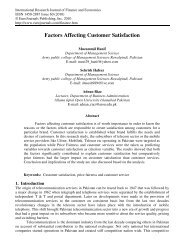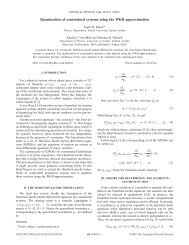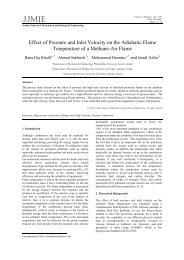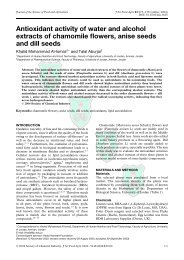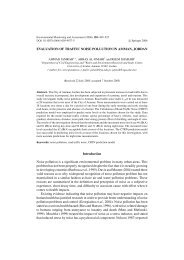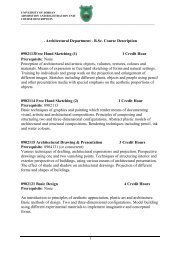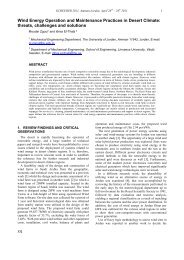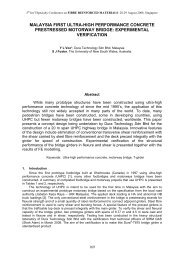A case of urinary bladder benign polyp treated successfully by ...
A case of urinary bladder benign polyp treated successfully by ...
A case of urinary bladder benign polyp treated successfully by ...
You also want an ePaper? Increase the reach of your titles
YUMPU automatically turns print PDFs into web optimized ePapers that Google loves.
A <strong>case</strong> <strong>of</strong> <strong>urinary</strong> <strong>bladder</strong> <strong>benign</strong> <strong>polyp</strong> <strong>treated</strong><br />
<strong>successfully</strong> <strong>by</strong> resection in a child<br />
Mujalli S Murshidi, Kamal Akl<br />
Department <strong>of</strong> Urology, Jordan University Hospital, P.O. Box 13245, Amman 11942, Jordan<br />
Abstract<br />
We report a <strong>case</strong> <strong>of</strong> a 3-year old boy that presented with recurrent urine retention secondary<br />
to a <strong>bladder</strong> <strong>polyp</strong>. Acute urine retention is not common in children. It may be<br />
secondary to dysuria whether from <strong>urinary</strong> tract infection, vaginitis, meatal ulcer, severe<br />
constipation with fecal masses compressing the <strong>bladder</strong> neck, voiding dysfunction, or from<br />
medications such as sympathomimetics. [1] Urethral obstructive lesions such as valves or<br />
stones may present with acute urine retention. Bladder <strong>polyp</strong>s, however, are a very rare<br />
cause <strong>of</strong> acute urine retention in children.<br />
The boy was admitted to the Jordan University Hospital with recurrent acute urine<br />
retention and painless gross hematuria <strong>of</strong> 1-weeks duration. There was a history <strong>of</strong> <strong>urinary</strong><br />
frequency, urgency, and suprapubic pain <strong>of</strong> 2 weeks duration. There was no history <strong>of</strong> a<br />
urine catheter. Physical examination was noncontributory. Urine analysis and culture were<br />
negative. A 24-hour urine collection revealed hyperoxaluria. A renal ultrasound was negative.<br />
The patient underwent urethrocystoscopy. There was a mobile greenish s<strong>of</strong>t <strong>polyp</strong>oid<br />
pedunculated mass measuring 1.2×0.6×0.5 cm in the <strong>bladder</strong> dome that was resected.<br />
Histopathology revealed an infarcted <strong>polyp</strong> with <strong>polyp</strong>oid fibrovascular tissue lined <strong>by</strong> a<br />
transitional epithelium lacking nuclear atypia. The stroma was edematous and congested<br />
with scanty inflammatory cell infiltrates. There was no evidence <strong>of</strong> malignancy. The patient<br />
had one recurrence <strong>of</strong> the gross hematuria without recurrence <strong>of</strong> the <strong>polyp</strong> as<br />
demonstrated on repeat cystoscopy. He was put on pyridoxine for the hyperoxaluria.<br />
Recurrent urine retention in children may result from a variety <strong>of</strong> causes. However, <strong>bladder</strong><br />
<strong>polyp</strong>s as a cause are rare. Genito<strong>urinary</strong> tract <strong>polyp</strong>s can occur anywhere from the renal<br />
pelvis to the urethra. [2],[3],[4],[5] Bladder <strong>polyp</strong>s are rare in both adults and children. They<br />
may present with gross hematuria, voiding dysfunction, [6] or urine infection. [7],[8],[9],[10] One<br />
should always keep in mind malignant tumours such as rhabdomyosarcoma, which may
present in a similar manner. Diagnosis is <strong>by</strong> histopathology. Polyps are usually <strong>benign</strong> and<br />
do not turn malignant or recur. Al Ahmadie and colleagues reported a giant fibroepithelial<br />
<strong>polyp</strong> in a 3-year old child. [11] In our patient, the location <strong>of</strong> the <strong>polyp</strong> allowed it to act as an<br />
intermittent valve, leading to urine retention alternating with symptom-free periods.<br />
The pathogenesis <strong>of</strong> <strong>bladder</strong> genito<strong>urinary</strong> <strong>polyp</strong>s remains to be elucidated. One<br />
hypothesis suggests that stone-initiated chronic irritation <strong>of</strong> the genito<strong>urinary</strong> mucosa<br />
leads to <strong>polyp</strong> formation. [5] The role <strong>of</strong> the stone and crystalluria in the initiation <strong>of</strong> the<br />
localized inflammatory trigger seems appealing.<br />
Murshidi proposed that chronic localized lamina propria edema may cause a mucosal<br />
bulge which culminates into a <strong>polyp</strong>, [5] but this does not explain the presence <strong>of</strong> congenital<br />
<strong>polyp</strong>s. In our patient, the chronic mucosal irritation with oxalate crystal may have contributed<br />
to localized edema and <strong>polyp</strong> formation. [12]


